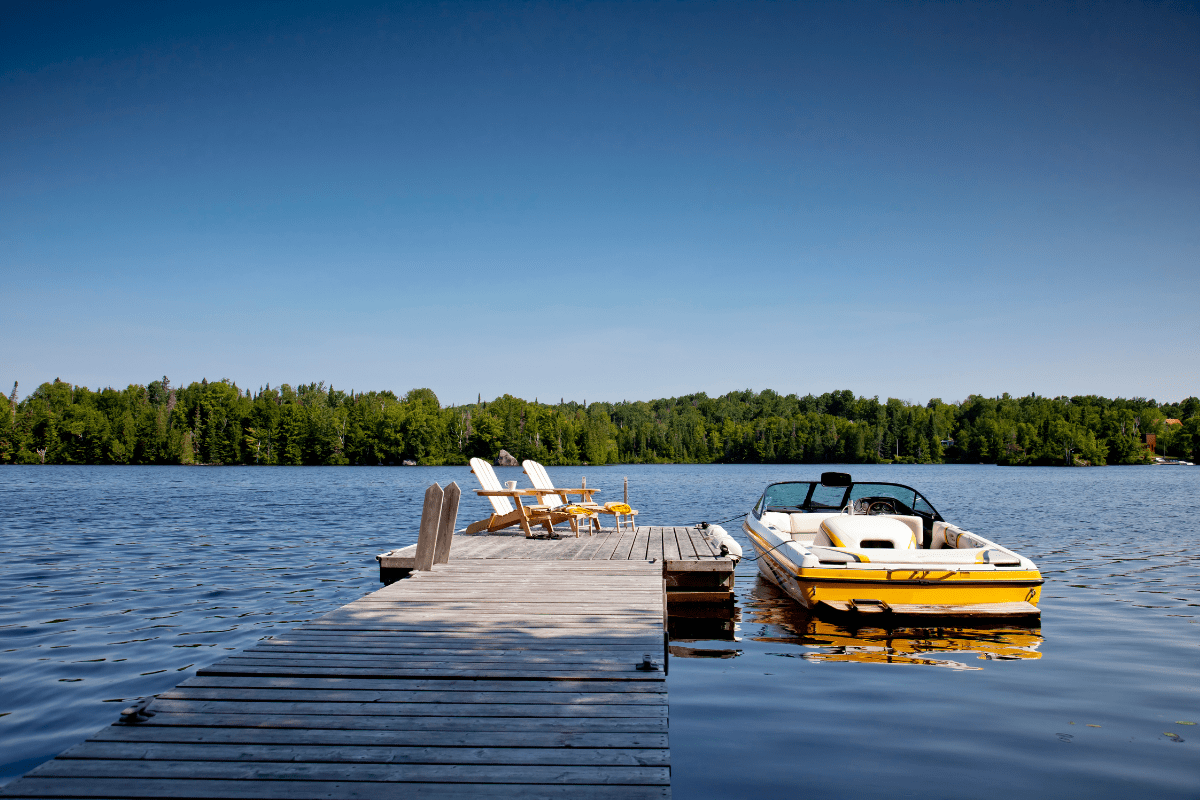Idaho's 2,000 lakes offer everything from Caribbean-blue waters surrounded by sagebrush desert to pristine alpine gems nestled beneath towering peaks, and most visitors never discover the best ones. With 148 square miles of water surface at Lake Pend Oreille alone and hidden treasures scattered across 83,570 square miles of diverse terrain, Idaho's lakes deliver world-class fishing, unexpected beauty, and adventures ranging from floating beach bars to backcountry solitude.
The northern giants that define Idaho's lake country
Northern Idaho's Panhandle region contains over half of the state's surface waters, anchored by three massive lakes that draw millions of visitors annually. These aren't your average mountain puddles… we're talking about bodies of water so large they have their own weather systems and submarine testing facilities.
Lake Pend Oreille: Where submarines and rainbow trout coexist
Lake Pend Oreille dominates the landscape as Idaho's largest and deepest lake, plunging 1,152 feet deep, making it the fifth-deepest lake in the United States. This 148-square-mile giant near Sandpoint produces more 20-pound rainbow trout than anywhere else in Idaho, with the state record 37-pound Gerrard rainbow caught here way back in 1947 (and yes, anglers are still trying to beat it).
The lake's exceptional depth provides ocean-like acoustic properties, which explains why the U.S. Navy maintains a submarine research facility here for sonar testing. Nothing says "gone fishing" quite like casting your line while nuclear submarines lurk somewhere beneath you. Beyond the fishing and military intrigue, visitors find 144 miles of shoreline dotted with sandy beaches, full-service marinas, and the 4,000-acre Farragut State Park, a former World War II naval training station that once housed 293,000 sailors.
The current kokanee population exceeds 2.5 million fish, the highest count since the mid-1990s, though the state maintains a $15 bounty program for lake trout to protect this valuable salmon fishery. It's probably the only place where you can get paid to go fishing, though don't quit your day job just yet.
Lake Coeur d'Alene: Beautiful, complicated, and home to a floating golf green
Lake Coeur d'Alene stretches 25 miles through Kootenai County and earned recognition from National Geographic as one of the world's five most beautiful lakes. The lake's northern shore hosts the famous Coeur d'Alene Resort with its floating golf green, a 5-million-pound moveable island that's repositioned daily because apparently regular golf wasn't challenging enough.
During winter months, hundreds of bald eagles congregate here to feed on spawning kokanee salmon, creating one of the region's most spectacular wildlife displays. The lake supports one of the few landlocked Chinook salmon fisheries in the United States, alongside trophy northern pike lurking in weedy backwaters.
Unfortunately, this beauty comes with baggage. The lake was designated a Superfund site in 1983 due to historical mining contamination, and phosphorus levels continue to increase despite overall water quality improvements since the 1970s. The state recently allocated $2 million in funds for phosphorus reduction projects, proving that even paradise needs maintenance.
Priest Lake: The crown jewel that actually lives up to its nickname
Priest Lake represents Idaho's "Crown Jewel," maintaining its pristine character despite being just 30 miles from the Canadian border. The crystal-clear waters produced the world's largest lake trout at 57 pounds 8 ounces in 1971, a record that still makes anglers weep with envy.
The connected Upper Priest Lake remains accessible only by foot, bike, or boat through a 2.5-mile natural channel called the Thorofare, keeping it blissfully free from jet ski enthusiasts and floating party platforms. Three state park units offer camping along sandy beaches, while the surrounding Selkirk Mountains provide a wilderness backdrop that's changed little since Jesuit missionaries first visited in the 1840s.
Southern treasures that rival any mountain destination
Southern Idaho's lakes prove you don't need to drive eight hours north to find spectacular water. These gems offer everything from tropical-looking waters to world-class sailing, often with better weather and shorter drives from Boise.
Bear Lake: The Caribbean of the Rockies (seriously)
Bear Lake straddles the Idaho-Utah border as the "Caribbean of the Rockies," its brilliant turquoise color created by suspended limestone particles that give the 109-square-mile lake its tropical appearance. The lake harbors four endemic fish species found nowhere else on Earth, including the Bonneville cisco that draws thousands of ice fishermen during spectacular January spawning runs.
North Beach provides over a mile of sandy shoreline with gradually sloping lake bottom perfect for families, while the 5,924-foot elevation keeps summer temperatures comfortable for swimming. The lake's unique color intensifies on sunny days, creating photo opportunities that will make your Instagram followers think you've secretly flown to the Bahamas.
Redfish Lake: Where salmon used to turn the water red
Central Idaho's Redfish Lake sits at 6,547 feet elevation within the Sawtooth National Recreation Area, where 387-foot depths reflect the dramatic peaks of the Sawtooth Mountains. Named for the massive sockeye salmon runs that historically turned the lake red during spawning season, Redfish Lake now serves as critical habitat for endangered Snake River sockeye salmon.
The historic Redfish Lake Lodge, established in 1929, operates ferry service across the lake to wilderness trailheads, saving hikers six miles of walking. Seventeen miles of shoreline trail circle the lake, while boat rentals starting at $385 per day provide less strenuous ways to explore. Just remember that summer water temperatures peak at a refreshing 62 degrees, so that polar plunge feeling is included free of charge.
Lake Cascade: The perch capital that knows how to party
Lake Cascade spreads across 47 square miles as Idaho's fourth-largest water body, offering 86 miles of shoreline dotted with 10 state park campgrounds and 279 individual campsites. The reservoir's reputation for trophy yellow perch attracts ice fishermen from across the West, with the lake producing multiple state and world records.
Summer visitors find excellent conditions for water skiing and wakeboarding, while consistent afternoon thermal winds create ideal sailing conditions. The nearby town of Cascade provides full services, and Kelly's Whitewater Park offers Idaho's first whitewater kayaking park for those seeking river thrills between lake days.
Fishing opportunities that exceed most anglers' dreams
Idaho's lakes support fishing opportunities that range from easy family outings to pursuit of world records. The diversity is staggering, from tiny alpine brookies to monster sturgeon.
The state's official records tell impressive stories: a 42-inch lake trout from Payette Lake caught in 2025, a 32-pound bull trout world record from Lake Pend Oreille, and various other giants that make fishing tales actually believable. Deadwood Reservoir ranks as the "crown jewel" of kokanee fisheries with fish averaging 15-16 inches.
For bass anglers, C.J. Strike Reservoir provides year-round action with both largemouth and smallmouth bass. Winter transforms many lakes into ice fishing destinations, with Lake Cascade's giant perch and Bear Lake's cisco runs creating seasonal phenomena that draw thousands of anglers.
Essential fishing information for planning your trip:
- Licenses available at gofishidaho.org
- General trout limit: 6 fish daily
- Free fishing day: Second Saturday in June
- Spring: Best for active trout
- May-July: Peak kokanee season
- Winter: Ice fishing paradise
- Special regulations protect threatened species
Planning your visit: The practical stuff nobody tells you
Understanding Idaho's seasonal patterns and logistics can make or break your lake adventure. Trust me, showing up at Redfish Lake in early June expecting tropical swimming weather is a mistake you'll only make once.
When to visit each type of lake
Peak season runs June through August when water temperatures reach comfortable swimming levels and all facilities operate at full capacity. Mountain lakes like Redfish might not fully thaw until late June, and even then, "comfortable" is relative… think "refreshing" rather than "bathwater warm."
Spring fishing often provides the year's best action as trout become active and bass move into shallow spawning areas. Fall brings spectacular wildlife viewing as bald eagles congregate at Coeur d'Alene Lake. Winter transforms lakes above 4,000 feet into ice fishing destinations.
Wildfire season from July through September can impact air quality and occasionally force closures. Check Idaho 511 for current road conditions, particularly important for winter access to mountain lakes.
Getting there and where to stay
From Boise, Lucky Peak sits just 20 minutes away while Priest Lake requires a 7-8 hour drive north. Most lakes have paved access roads suitable for standard vehicles and boat trailers, though some dispersed camping areas may require high-clearance vehicles.
Accommodations range from primitive dispersed camping to full-service resorts:
- Lake Cascade: 279 campsites including full RV hookups
- Priest Lake: 93 sites with water/electric
- Farragut State Park: 183 campsites
- State park reservations: 888-922-6743
- Federal campgrounds: Recreation.gov
Day use fees run $7 per vehicle at state parks, though the $10 annual Idaho State Parks Passport provides unlimited access for residents. Out-of-state visitors can purchase an $80 annual sticker, which pays for itself after about 11 visits.
Hidden gems for the adventurous
Beyond the famous destinations, Idaho conceals alpine jewels accessible only to those willing to hike. These spots won't have amenities or cell service, but they also won't have crowds or boat noise.
Goat Lake in the Sawtooth Wilderness rewards an 8-mile round-trip hike with striking blue waters surrounded by dramatic cliffs. The Boulder Chain Lakes offer unparalleled solitude for backpackers, while Alice Lake's moderate 6-mile trail leads to crystal-clear waters perfect for swimming (if you consider 55-degree water swimmable).
For the truly unique, Iron Bog Lake near Craters of the Moon features a mountain peak rising directly from the water. Box Canyon Springs, America's 11th largest spring, pours 118,000 gallons per minute into a pristine blue pool. These hidden destinations often require local knowledge or careful map study, but deliver experiences impossible at crowded mainstream lakes.
Environmental challenges and how you can help
Idaho's lakes face mounting environmental pressures that threaten their pristine nature. It's not all doom and gloom, but awareness helps preserve these treasures.
Toxic algal blooms now affect 20-25 Idaho lakes each summer, becoming more common over the past 15 years. Climate change compounds these challenges through altered precipitation patterns and warmer water temperatures that favor algae growth.
The good news? Conservation efforts are working. Lake Cascade reduced phosphorus levels by 57 percent after algae problems in 1993. The Idaho Conservation League coordinates volunteer monitoring programs, with 30 volunteers testing Lake Pend Oreille monthly from May through September.
You can help by cleaning your boat between lakes, properly disposing of waste, and respecting capacity limits at popular spots. That $22 out-of-state boat sticker? It funds invasive species prevention that keeps Idaho's lakes from suffering the fate of lakes elsewhere in the West.
The bottom line on Idaho's lakes
Idaho's 2,000 lakes deliver far more than typical mountain recreation. Whether you're chasing 37-pound rainbow trout, searching for family-friendly beaches, or seeking backcountry solitude, these waters offer adventures limited only by imagination and willingness to explore.
The famous lakes earn their reputations, but don't overlook the hidden gems that require a bit more effort to reach. Plan ahead for seasonal conditions, make camping reservations early, and remember that even paradise needs protection. Most importantly, bring a camera, because nobody back home will believe that turquoise water at Bear Lake is actually in landlocked Idaho.





